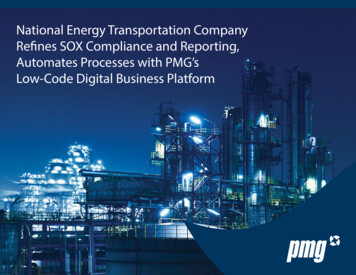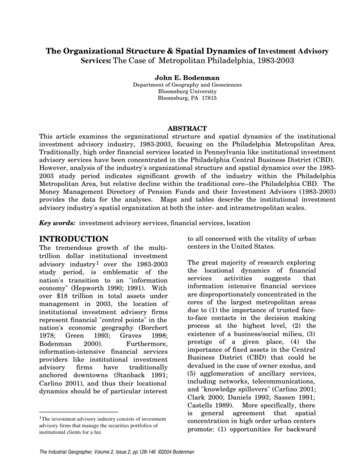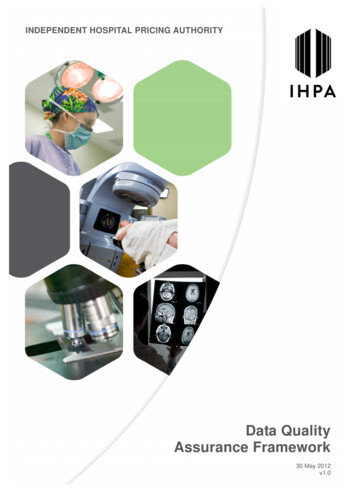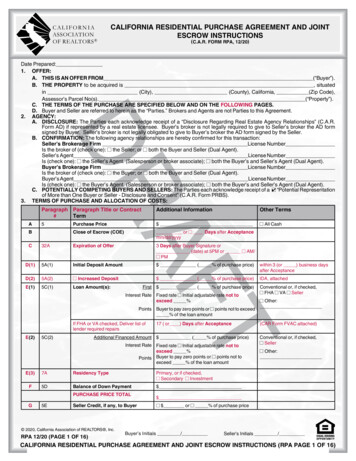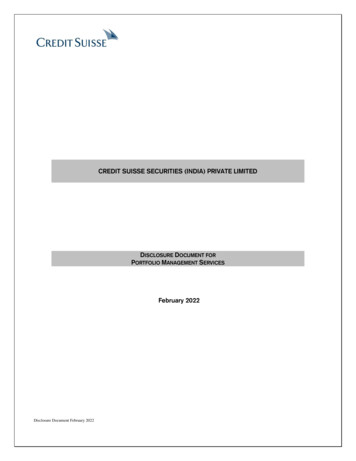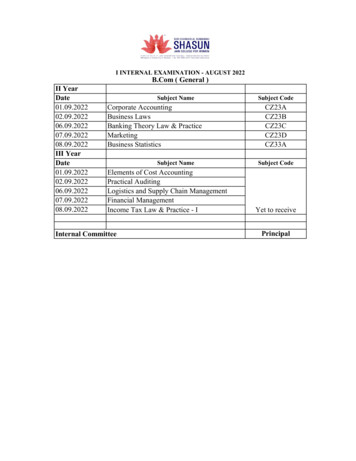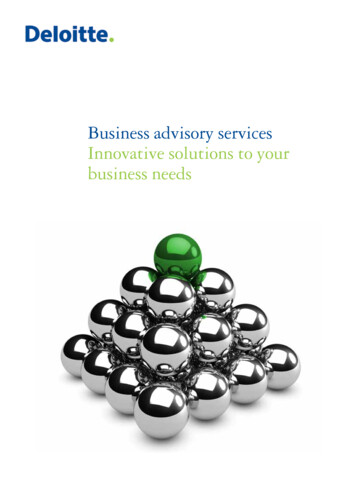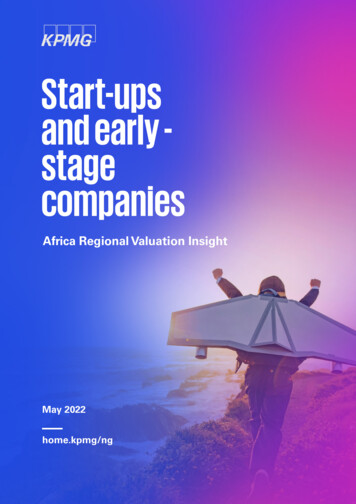
Transcription
2022 KPMG Advisory Services, a partnership registered in Nigeria and a member firm of the KPMG global organisation of independentmember firms affiliated with KPMG International Limited, a private English company limited by guarantee. All rights reserved.1
Dear readerAlthough a resurgence of widespread infections remains a possibility, theincreased pace of the global reopening signals hope and optimism that theworst of the pandemic is behind us. With a renewed focus on the future,we can look forward to the promise of greater workplace flexibility andinnovation in remote collaboration.A key lesson borne out of the pandemic is the urgent need for economiesall over the world to become more innovative. Nowhere was this moreapparent than in Africa where a significant innovation deficit magnified theeffect of the pandemic on the continent, eventually forcing many economieson the continent to lift restrictions at the height of the pandemic in orderto survive. In this renewed focus on innovation, start-ups and early-stagecompanies, that design products that sculpt our future and address some ofthe world’s greatest challenges head-on, will lead Africa’s drive to becomemore innovative. As such, it is important to understand the appropriate wayto value start-ups and early-stage companies to be better-placed to providethem with the right amount of funding needed to thrive and grow.In this Brief, we address typical questions that arise when valuing early-stagecompanies:– Which methodology should be used to properly capture the value potentialof an early-stage company?– How is the specific risk profile of early-stage businesses reflected in a valuation, even when they have zero sales or have not yet obtained requiredregulatory approvals?– Is there a way to assess potential value development over time?Answers to these questions would facilitate more transparent discussionsbetween founders and investors regarding value and price of early-stagecompanies – allowing for a better allocation of risk and return.In addition, we include a summary of current capital market data such asrisk-free rates, country risk premiums and growth rates for selected Africanmarkets, which can all be found in the final section of this Brief.We look forward to discussing how we could help you assess the potential ofyour business and the possibilities the future holds.Yours faithfully,Ijeoma Emezie-EzigboPartner & Head,Transaction ServicesGbolahan AshagbeDirector,Valuation 2022 KPMG Advisory Services, a partnership registered in Nigeria and a member firm of the KPMG global organisation of independentmember firms affiliated with KPMG International Limited, a private English company limited by guarantee. All rights reserved.2
Early-stage companies: Ayear of exponential growth!Investments in early-stage companies represent an asset class of their own, attracting growing interest acrossthe world. The number and size of successful start-ups is on the rise; investors have never seen unicorns at suchunprecedented levels.92%4.3 billionGlobal venture capital funding increased 92% yearover year to USD 643 billion in 2021. This is 23x thegrowth of 4% achieved in 2020 and represents a 10xgrowth compared with a decade earlier. This growthwas driven by strong growth in early-stage fundingwhich grew 101% year over year.2African start-ups raised over USD 4.3 billion in 2021.3This is a 2.5x growth over funding raised in 2020.Funding was concentrated in the fintech sectorwhich accounted for over 50% of funding. Othersectors that saw sizeable funding include health &biotech, logistics and education.44230.4 billion89%23813 mega dealsEarly-stage companies secured USD 230.4 billion infunding – representing 39% of total start-up fundingglobally in 2021.This is a 101% growth over fundingreceived in 2020.2238 venture capital-backed start-ups went public atvaluations above USD 1 billion in 2021. This represents a 290% growth over the 61 start-ups thatachieved this feat in 2020.23.5x586 start-ups attained unicorn status (a valuationover USD 1 billion) in 2021. This is a 3.5x increaseover the 167 start-ups that attained the status in2020. This represented an average of over 10 newunicorn start-ups per week.2Early-stage funding accounted for 89% of announced funding deals and 50% of all start-up funding deals in Africa in 2020.5Africa recorded at least 13 mega deals (single, non-M&Adeals with funding values over USD 100 million) in 2021– a key sign of the increased global attractiveness ofstart-ups on the continent.45In 2021, five African start-ups attained unicorn status:Flutterwave, Opay, Wave, Andela and Chipper Cash.This represents a 2.5x growth over the total number ofunicorns minted on the continent up to that point since2016.6 2022 KPMG Advisory Services, a partnership registered in Nigeria and a member firm of the KPMG global organisation of independentmember firms affiliated with KPMG International Limited, a private English company limited by guarantee. All rights reserved.3
Start-ups - Valuation considerationsIn addition to general market risks associated with valuing companies, specific risks should be considered inany early-stage company valuation. Failing to appreciate a start-up’s specific risk profile can lead to inaccurateassessment of its full value potential in an exit scenario unless there is sufficient transparency of existing risks andopportunities to promote robust price negotiations. How can this be considered in the valuation approach? Do thespecial characteristics of start-ups require unique valuation procedures? We examine these questions, discuss thearchetypical evolution of a start-up’s risk profile and explore how this can be reflected in valuations through a dynamicvaluation approach.Start-ups – a somewhat traditional asset classFrom an economic viewpoint, start- ups areinvestments involving an upfront payment today –e.g. founders’ labor and intellectual property, thecontribution of business ideas or financial resources– with the expectation of receiving (higher) financialresources at a later date, e.g. upon (private or public)sale. How high expected future cash flows should bedepends on the perceived level of risk of the foundersand investor. It is hardly surprising that the respectiveparties may have vastly differing opinions as to thefuture development and financial outcome of an earlystage company. Founders and investors may havegreatly diverging views on what should be contributedby each party, and what share in the start-up eachparticipant should receive. Many start-ups alreadyhad numerous financing rounds and changes inownership behind them, especially at the beginning,meaning that issues around proper distribution ofvalue (i.e. financial performance and risk) betweenthe participants are more common than in deals withestablished companies. Insufficient information makesit difficult to get expectations right and find alignment.With future operational performance still to be proven,the various stakeholders are most likely to disagree onvalue expectations.With this in mind, utmost transparency is critical inmaking valuation assumptions.Regardless of the purpose of the valuation, acompany’s value is always based on the expectationof future uncertain payments – usually in the form ofdistributions or exit proceeds.Founders and investors expect adequate futurereturn for their invested capital, and start-ups areno exception. Forecasting future financial returnstherefore plays a central role in the valuation ofstart-ups. The time frame (usually the exit time of aparticipant), absolute expected amount (reflecting theperformance) and expected range (reflecting the risk)of possible returns are all relevant. In this respect,start-ups are no different from any other investment.Taking an investment-oriented view, forward- lookingvaluation method based on future cash flows, i.e.discounted cash flow (DCF) method, should be thepreferred valuation method for start-ups.When considering the peculiarities of start-ups (e.g.absence of revenue, unknown interest of customers inthe new product or service, evolving operating model,etc.), the traditional application of the DCF method maynot appropriately reflect the risk-return profile of start-upsat first glance. This may suggest established cash floworiented valuation methods may be difficult in practice.Therefore, “alternative” valuation methods are oftenapplied to start-ups.Market multiples as an alternative valuation methodFor early-stage companies there are, without doubt,challenges associated with forecasting future cash flows,correctly reflecting the risks (specific and systematic)as well as capturing the evolving risk-return profile overtime. Start-ups typically face a high number of valuationevents, e.g., development milestones reached as well astransactions due to investor changes. Alternative valuationmethods, typically based on the market approach andcomparison of specific price multiples, are thereforefrequently used. These alternative valuation methods,however, do not offer a solution to the problem, butabstract from the problem itself by greatly simplifying it.As a result, they sometimes result in a high degree ofuncertainty of the value conclusion, lack transparency,or mix up long-term company values with short-termachievable company prices due to initially rather shortterm investment horizons. In particular, methods that arestrongly oriented toward purely operational key figures(e.g. number of customers, click rates, etc.) attempt tocompensate for the lack of information or even readinessregarding the start- up’s operational business model(organisational and cost structures).Methods based on financial key figures (e.g. sales) areintended to circumvent the problem of negative earningsin the initial loss-making phase. These multiple-basedmethods, which focus on operational or financial KPIs,assume that key figures obtained from – somewhat –comparable companies can be transferred to a start-upfor pricing purposes. They are technically quick to apply,replace the subjective price perceptions of the participantswith the supposed objectivity of the market, and canappear to save time and costs. However, they providean initial, very rough price (but not value!) estimate.While multiple-based method play an important role indetermining an initial rough price estimate based onlimited information, the result cannot be compared to thedetail of a more intrinsic, future-oriented valuation based 2022 KPMG Advisory Services, a partnership registered in Nigeria and a member firm of the KPMG global organisation of independentmember firms affiliated with KPMG International Limited, a private English company limited by guarantee. All rights reserved.4
on expected returns specific to the valuation target.Start-up valuations are complicated by the fact thatthe multiples typically observed for other companiescannot be applied due to the limited empirical basisavailable for new business models.In other words, the innovation brought by a specificstart-up cannot be captured through the application ofprice multiples observed for other companies as theirbusiness models are different.The disadvantage of missing or insufficient financialinformation for start-ups is often put into perspectivesince the initial focus on the operational value driversrequires a thorough assessment of the business andoperating model. Every sound valuation assessmentshould consider the operational value drivers of thebusiness model and not just the resulting financialKPIs. This is often neglected when valuing establishedcompanies or is justified by the (implicit) assumptionthat established business models can be reflectedin a consistent future financial performance. Sincefinancial KPIs are merely the result of a transformationprocess from operational value drivers into financial figures,unsupported financial KPIs should not be considered asisolated value drivers. Only a transparent transformation ofthe operational value drivers into forecasts of the operationalperformance and then, forecasts of the financial KPIs providea solid basis for a valuation analysis. This method results inmore transparency and trust than a simple multiple-basedapproach. It also paves the way for a robust DCF valuation.Finally, the question of a “pre-money” and “post-money”valuation, which considers the value before and after theinjection of new funds, can only be disclosed consistently byperforming a future cashflow-based analysis – and not with amultiple-based pricing estimate.Transparency on return and riskThe addressee of a valuation should always be aware ofthe purpose of the valuation and the level of scrutiny it isintended to withstand. To speak for the development of aspecific early-stage company’s business and operating model– and the associated value development – it is essentialto show the transformation of the expected operationalvalue drivers into financial models. This is initially simple butgradually becomes more complex. 2022 KPMG Advisory Services, a partnership registered in Nigeria and a member firm of the KPMG global organisation of independentmember firms affiliated with KPMG International Limited, a private English company limited by guarantee. All rights reserved.5
Transparent transformation alsoenables consistentcommunication regarding theexpected development of thecompany’s performance andrisks.While performance cangenerally be measured byfinancial KPIs, the questionarises – especially for startups – of how to measure risksappropriately. Not doing somakes it difficult to allocate risksappropriately to all stakeholders.This brings us back to thespecial feature of early-stagecompany valuation describedabove: views can diverge greatlywhen it comes to determiningthe contribution of foundersversus investors, and the entitlement of individualstakeholders to shares in the early-stage company.Missing, insufficient or inadequately transparentinformation not only make it difficult to form the rightexpectations regarding future performance but alsohinders any fundamental assessment of assumed risk.This is precisely where the multiple-based valuationmethod fails. For start-ups, this is critical as the financialcontribution of an investor often represents the urgentlyneeded financing for the business. If the founders cannottransparently demonstrate the risks of their business,investors may only be willing to invest if they can payless than the fair price (given the difficulty to assessrisks) or are promised more than the fair future return forthe amount invested.If one group of stakeholders receives more returnthan they should considering their risk position, thisis inevitably at the expense of the other stakeholders:founders in the case of start-ups. They pay the pricefor the risks such that, due to lack of risk transparency,they must assume more of the overall risk than wouldbe allocated to them in relation to their expected return.This often comes down to a lack of transparency andconsistency, not only regarding how the start-up’sperformance will develop, but also its risk profile.For a start-up valuation to be a reliable basis for anappropriate distribution of stakeholder shares, it mustanswer the two key questions clearly and coherently:What’s in it for me? What risks am I taking? Thesequestions reflect the risk/return profile underlying everyinvestment decision. With the right approach, this can befully depicted using established valuation methods, evenfor start-ups.The venture capital (VC) approachDue to limited history and significant change in cash flowgeneration over time, a start-up valuation requires a clearlink between the expected business model, operatingmodel and financial KPIs. This can be achieved throughproper business plan modeling, complemented by arobust commercial due diligence on the assumptionsused (market share acquired, pricing, cost structure, etc.).The translation of expected operational performance intofinancial KPIs is then only a technicality, in the form ofbuilding forecasts of integrated financial statements.Considering the business and operating modeltransformed into an estimate of the future financialperformance provides insights into the “What’s in itfor me?”, but what about the risk a founder or investoris taking? Academic research and empirical evidencefrom polls on expected rates of return by venturecapitalists investing in early-stage companies are avaluable resource for assessing relevant discount rates.Depending on the development stage, rates range from70% or higher in the seed stage, falling to 20% in thelate stage. While these discount rates appear high, itis important to bear in mind the high failure rates ofearly-stage companies. Table 1 provides a high-levelsummary of selected studies and briefly describes thecharacteristics of each development stage. 2022 KPMG Advisory Services, a partnership registered in Nigeria and a member firm of the KPMG global organisation of independentmember firms affiliated with KPMG International Limited, a private English company limited by guarantee. All rights reserved.6
Stage of developmentPlummer / QED median (7)Scherlis and Sahlman (8)Sahlman, Stevenson andBhide (9)Damodaran (10)Seed stage50% - 70%50% - 70%50% - 100%50% - 70%First stage40% - 60%40% - 60%40% - 60%40% - 60%Second stage35% - 50%30% - 50%30% - 40%35% - 50%Bridge/Initial PublicOffering (“IPO”)25% - 35%20% - 35%20% - 30%25% - 35%Seed stageThe seed stage corresponds to companies that are lessthan a year old, have completed or are completing researchand development of their product and have a businessplan. The venture funding provided in this stage is to beused toward product development, prototype testing andmarketing.First stageSometimes also called the “emerging stage”, enterprisesin the first stage have developed prototypes that appearviable and for which further technical risk is deemedminimal. However, the commercial risk associated with theproduct may be significant.Second stageAlso commonly referred to as the “expansion stage”,enterprises in the second stage have usually shippedsome products to consumers (including beta versions) andreceived feedback.The specific elements of an early- stage business plansuch as the addressable markets, volume and pricingassumptions, the operating model, investment andfunding requirements, etc. should be considered inthe cash flow projections. However, those cash flowprojections do not reflect any particular risk associatedwith the early stage of the target company.Appreciating the current stage of development of thecompany being valued as described above is critical inorder to identify the corresponding discount rate, i.e. riskexpectation, from VC investors.Like the multiple-based approach, the expected rates ofreturn from VC investors depend on the comparabilityof the risk profile within a given stage. It is certainlyarguable that a first stage company in the financialservices sector that has already received an operatinglicense from a regulator might be less risky than a firststage company in the biotech sector where final approvalfrom a drug administration agency is outstanding. Theobservable ranges within each stage are neverthelessbroad and require additional assessment. The applieddiscount rate is a risk measure that provides moretransparency than a multiple.Bridge/IPOThe final stage of venture capital financing, the bridgestage is when financing is required for activities such aspilot plant construction, production design and productiontesting, as well as bridge financing in anticipation of a laterIPO.their founders). Variations then reflect additional upsidepotential (“best case”) or specific risks such as delayedmarket entry, change in pricing assumptions, etc.(“worst case”).In practice, as many as four or five different scenarioscould be established – each with a consistent set ofcorrelating assumptions – including a scenario where thecompany fails. Given the very high growth rates typicallyexpected at first for early-stage companies, forecastingperiods for each of the scenarios may be extended toinclude a slow-down phase. From this point onwards,cash flow growth decelerates progressively to reacha steady state where cash flow increases in line withmarket growth and currency inflation.The probability weighted DCF approachTo reflect the risks and uncertainties specific to the earlystage company being valued; various business planscenarios can be developed. Typically, these scenariosare structured around a “base case”, which reflects themost likely expected scenario for the start-up (usually, byOnce the various scenarios have been developed, aDCF valuation can be applied separately for each one.The traditional Capital Asset Pricing Model (CAPM) canbe used to determine the discount rate. This involvesidentifying listed companies in a similar sector to theearly-stage company being valued. As listed companiestend to be more mature and less risky than companiesstill in their earlystage, the CAPM alone will not reflect the riskassociated with the target company.As the DCF method can now be implemented for thedifferent scenarios, the probability of occurrence – alsoreferred to as the probability of success (PoS) – can bedefined. Each scenario should be weighted such thatAll scenarios provide different possible outcomes to thethey total 100%. The final value concluded for the early“What’s in it for me?” question.stage company is the aggregate of the DCF values foreach scenario weighted by the PoS. 2022 KPMG Advisory Services, a partnership registered in Nigeria and a member firm of the KPMG global organisation of independent7member firms affiliated with KPMG International Limited, a private English company limited by guarantee. All rights reserved.
Reflecting risks with transparency:Probability-weighted DCF approachWhile in the VC approach the risk of the early stage isfully reflected in the high discount rate, the same riskis reflected in the probability-weighting of the differentscenarios, and the applied CAPM-based lower discountrate is neutral with respect to the early-stage risk. Whilethere is some element of personal preference, we clearlyfavor the probability-weighted approach as it is muchmore reasonable to discuss assumptions for the variousscenarios and the likelihood of each scenario than toargue over an abstract early- stage risk premium in thediscount rate. By transparently presenting the expectedperformance (return) and risk, the probability-weightedDCF method makes a valuable contribution to thereduction of any expectation gaps among stakeholdersand supports fair allocation of value between foundersand investors.The estimate of the PoS is subjective, with founderstypically putting more weight on the base case andpotential upside scenarios, whereas VC investors may bemore skeptical. In that respect, the use of the expectedrates of return of VC investors in the probability-weightedDCF approach may be appropriate, i.e. a combination ofboth approaches. This requires a sensible and pragmaticassessment of the various key inputs. Parties shouldalso observe the common valuation principle of notaccounting twice for the same risk – here, in the cashflows and in the discount rate. A triangulation of differentsets of probabilities and discount rates might be usedto support convergence on a central value through thismulti-scenario, probability-weighted DCF result. This allincreases transparency of the underlying thought processand acceptance of all stakeholders.Finally, it should be noted that – as everywhere incompetitive markets – transparency from the perspectiveof an individual stakeholder is always helpful if it supportsa better negotiating position. Prices in real marketsare not formed in theory but based on negotiations.Negotiating advantages come from information or anyother factors that improve the lack of transparency sooften cited as justification for price reductions.Value increase over time based on an evolving riskprofileEarly-stage companies typically have in common anextremely high speed of development.As the company evolves, the business becomes morerobust and operational milestones are reached, reducingthe risk of the venture. The figure on page 8 showingexpected VC rates of return illustrates how risk clearlydeclines from one stage to the next.A value conclusion is a statement at a single point intime. It is of enormous interest to all stakeholders, andnew investors in particular, to understand how the valueof an early-stage company is likely to increase over time.To address this need, the probability- weighted DCFmethod is once again especially relevant: the scenarios– and the PoS attached to them – can also be relatedto future milestones. These can include operational(successful prototyping), regulatory (administrativeapproval) and commercial (securing key client contract)aspects. At the point of the valuation analysis,assumptions relating to financial performance will remainthe same. Except for the different time value of money(which is usually immaterial in the context of high-growthcases), the overall valueconclusion for a future date – in six- or twelve-months’time, for example – would not change. The probabilityassessment of the different scenarios may vary, however,and the risk (i.e. the discount rate) will be lower. Thesetwo factors do have a material impact on value and couldbe quantified applying these three steps:1. Define key milestones over the business plan period2. For each key milestone achievement, review the probability-weighting (PoS) of the already developed cashflow scenario 2022 KPMG Advisory Services, a partnership registered in Nigeria and a member firm of the KPMG global organisation of independentmember firms affiliated with KPMG International Limited, a private English company limited by guarantee. All rights reserved.8
3. Reassess the applied discount rate under the assumption that the key milestones have been metAdapting these inputs in a dynamic, probability-weighted DCF analysis enables future value developments over timeto be anticipated based on expected business achievements and risk development. The result is a healthy basis fordiscussion between founders and investors in an approach which transparently lays down not only the expectedperformance and risk, but also the value upside.Engaging the right experts to deal with the complexity of early-stage company valuationsKPMG Valuation Services regularly assists founders, VC investors as well as corporates investing in start-ups atvarious scales, from high-level value indications to deep dive analyses. Our valuation experts have profound sectorknowledge in fintech, e-commerce, healthcare, and other common start-up businesses.Many clients have benefited from our approach combining feasibility study, business planning, financial modeling, andglobal valuation concepts as described above. They appreciate the value our methodology adds beyond any immediateneed for a value indication for events such as an upcoming financing round or investments. We help our clients tobetter understand the opportunities and risks associated with a venture – and we help them make better-informeddecisions.Value development over time15001200900600300030%25% 2022 KPMG Advisory Services, a partnership registered in Nigeria and a member firm of the KPMG global organisation of independentmember firms affiliated with KPMG International Limited, a private English company limited by guarantee. All rights reserved.20%9
Capitalmarketdata 2022 KPMG Advisory Services, a partnership registered in Nigeria and a member firm of the KPMG global organisation of independentmember firms affiliated with KPMG International Limited, a private English company limited by guarantee. All rights reserved.10
In this section, we provide a selection of capital marketdata that serve as proxies for key parameters in the DCFvaluation process – risk-free rates, country risk premiumsand long-term growth rates. This section covers:– Risk-free rates, country risk premium estimates andlong-term growth forecasts for a selection of majorAfrican economies.Risk-free rates: Risk-free rates rise across currenciesThe risk-free rate is the foundation on which the discountrate used in the DCF method is built. It can generallybe broken down into two key components that seek tocompensate the investor: the first for expected inflationand the second for deferred consumption. The baserate is considered to be free of risks except for risksembedded in the underlying currency and risks related toinvestments in the particular country (including political,legal, regulatory and tax risks, as well as the risk of amoratorium).As no investment is truly risk free, the risk-free rate istypically approximated by reference to the yield on longterm debt instruments issued by presumably financiallyhealthy governments. The historical risk-free rates forSouth Africa, Egypt, Nigeria and Kenya are below.While rates in South Africa and Kenya have remainedlargely stable, rates in Egypt and Nigeria have beenvolatile, with risk-free rates ranging between 13.70%and 18.11% in Egypt and between 7.42% and 15.54%in Nigeria over the last five years. In addition, the riskfree rates of all considered currencies increased in2021 compared to 2019, which could be consideredthe pre-COVID-19 level. This increase is a result of theheightened uncertainty that took hold in the globaleconomy due to the onset of the COVID-19 pandemic atthe start of 2020.Risk-free %7.42%13.28%13.40%13.50%13.20%13.66%13.62%Table 2Source: FMDQ, Capital IQ, investing.comApproach: Risk-free rates taken to be the yield on the longest-term active bonds issued by national governments of the respective countrie 2022 KPMG Advisory Services, a partnership registered in Nigeria and
time. Start-ups typically face a high number of valuation events, e.g., development milestones reached as well as transactions due to investor changes. Alternative valuation methods, typically based on the market approach and comparison of specific price multiples, are therefore frequently used. These alternative valuation methods,
